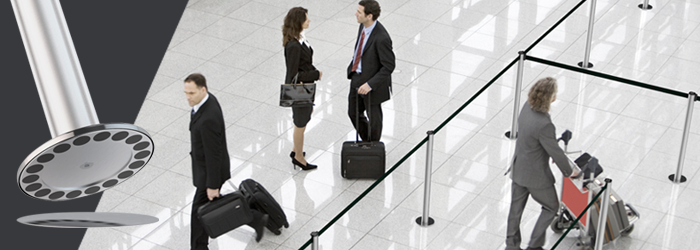
How Top Airports Are Using Magnetic-Mounted Stanchions for Queue Management and Passenger Flow [Case Study]
As airports look to modernize their operations, they look to solutions that meet their requirements for operational efficiency, passenger experience, and aesthetics. Magnetic-mounted stanchions provide an alternative to traditional core-drilled or portable stanchions in security checkpoints, ticketing, and other queues. The strong magnetic base helps to create and maintain orderly queues and simplify queue reconfiguration.
Beyond the basics, magnetic base stanchions deliver unexpected benefits to some of the world’s busiest airports. Posts are kept firmly in place to maintain the integrity of the queue, yet still quickly remove from the floor plate when needed. The low profile of the magnetic bases maximizes queuing space, while the clean, modern look enhances airport aesthetics. Finally, their quick and easy installation process requires little to no disruption to passengers so airports can continue to operate at a productive level.
To illustrate these benefits, we have put together a new airport case study detailing how three leading airports have adopted magnetic-mounted stanchions.
Atlanta International Airport (ATL) was undertaking a series of renovation and modernization projects under their “ATLNext” initiative. Lavi Industries was chosen to supply approximately 1,000 stanchions within the main security area of the domestic terminal. The stanchions were installed in a 4x4 grid pattern, mounted to the floor with magnetic bases. This massive configuration allows the airport to maintain the integrity of the new flooring it had installed as part of the renovation while creating a robust and flexible queuing area.
San Francisco International Airport (SFO) chose Lavi Industries to supply magnetic base stanchion solutions for security checkpoints throughout the airport. The primary challenge was to increase queuing capacity within these crowded areas. An additional challenge was to preserve the flooring in the checkpoint areas which consisted of carpet and terrazzo floor areas.
Dallas Fort-Worth Airport (DFW) was one of the earliest adopters of Lavi Industries’ magnetic-base stanchions. They chose the solution as part of an overarching initiative to improve the passenger experience throughout the airport. After recognizing the benefits of its initial installation, DFW expanded the installation of magnetic stanchion bases throughout the entire airport.
Read the full case study here.
SUBSCRIBE
Subscribe to stay up-to-date with new products, resources information and news.
RECENT RESOURCES
4 Psychological Reasons Your Customers Hate Waiting In Line
ViewFrom Bleachers To Bookstores: 4 Campus Crowd Control Solutions
ViewCrowd Control Systems for Large Venues
ViewWrigley Field Case Study: Just Walk Out Technology
View








